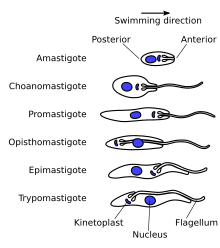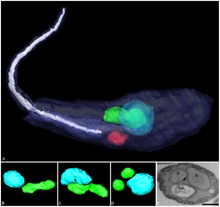Trypanosomatida
[citation needed] Among commonly studied examples, T. brucei, T. congolense, and T. vivax are extracellular, while T. cruzi and Leishmania spp.[10] A variety of different morphological forms appear in the life cycles of trypanosomatids, distinguished mainly by the position, length and the cell body attachment of the flagellum.The kinetoplast is found closely associated with the basal body at the base of the flagellum and all species of trypanosomatid have a single nucleus.[citation needed] Notable characteristics of trypanosomatids are the ability to perform trans-splicing of RNA and possession of glycosomes, where much of their glycolysis is confined to.These trypansomatids (Strigomonas oncopelti, S. culicis, S. galati, Angomonas desouzai, and A. deanei) are in turn known as SHTs, for symbiont-harboring trypanosomatids.In S. culicis at least, the TPE helps the host by synthesizing heme[7] and producing essential enzymes, staying tethered to the kinetoplast.
AlbianrecentPreꞒTrypanosoma cruziScientific classificationEukaryotaEuglenozoaKinetoplasteaStrigomonadinaekinetoplastidunicellular organismsflagellumparasiticinsectsvertebrateinvertebrateintracellular parasitesTrypanosoma bruceitrypanosomiasissleeping sicknesstsetse fliesChagas diseaseT. cruzitriatomineleishmaniasisLeishmaniasandfliesPaleoleishmaniaDominican amberBurdigalianHispaniolaTrypanosomaT. antiquusdixenousPhytomonasmonoxenousKinetoplastibacteriumBlastocrithidiaJaenimonasWallaceinaProteomonasTrypanosoma equiperdumLeishmania donovaniCrithidia luciliaeCrithidiaLeptomonasNovymonasAngomonas deaneiAngomonasKentomonasStrigomonasheteroxenousintestineinsectleechesplantsbloodstreamintracellularT. bruceiT. congolenseT. vivaxAfrican trypanosomiasismeiosisgenetic exchangesexual reproductionmorphologieskinetoplastbasal bodyAmastigoteLeishmania mexicanapromastigotetrans-splicingglycosomesglycolysisacidocalcisomeorganelleBacteriaPseudomonadotaBetaproteobacteriaBurkholderialesAlcaligenaceaeCa. "Kinetoplastibacterium"endosymbiontStrigomonas oncopeltiS. culicisAngomonas desouzaiA. deaneiCandidatusTaylorellaAchromobacterDiaphorina citriInternational Journal for ParasitologyTrends in ParasitologyBibcodeNatureNature Reviews MicrobiologyGenes & DevelopmentNew York NYMcGraw HillLancet Infectious DiseasesJournal of Cell ScienceJournal of Cell BiologyPhilosophical Transactions of the Royal Society BWorld Health OrganizationChisholm, HughEncyclopædia BritannicaExcavataDomainDiaphoretickesAmorpheaDiscobaJakobeaJakobidaAndaluciidaeHistionidaeJakobidaeStygiellidaeTsukubeaTsukubamonadidaTsukubamonadidaeDiscicristataPercolozoaNeovahlkampfiidaeGruberellidaeHeteroloboseaAcrasida




